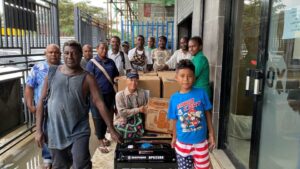BY JOHN HOUANIHAU
THE impact of sea level rise remains a major concern for many coastal communities and low-lying atolls across the country.
One of the worst affected regions when it comes to global warming is West Are’are in the southern region of Malaita.
Apart from the Ontong Java atolls and its communities in the outer islands of Malaita, Pipisu Village, a coastal Catholic community in West Are‘are, is also battling the adverse effects of sea level rise.
Located in the heart of the West Are‘are lagoon, Pipisu was once a little paradise of its own.
Its landmass was covered with green grass, beautiful trees, tall coconut palms and a variety of flowers.
One of their main sources of food and income was coconut, according to Pipisu villager Donald Mamanuana.
“We used to have varieties of coconuts which people get for food and income,” the young lad said.
“Things have since – the trees that usually provide shade, the green grass that cover the land, the coconut trees where our grandparents had left for us and the beautiful flowers that beautifies our village have all gone,” Mamanuana said.
“They have vanished and we can no longer enjoy this wonderful setting anymore due to the effects of sea level rise,” he added.
Mamanuana said in the past food crops such as potatoes, tomatoes, sugar cane, pawpaw, pineapple, bush apples and vegetables with the likes of slippery cabbage and beans are some of the foods that were readily available in the village.
He stated that since the community started experiencing the impacts of sea level rise as a result of global warming, Pipisu community is slowly sinking under the water – losing its uniqueness and livelihood in the process.
Mamanuana said the situation gets worse between the months of December and June because of rough seas and big waves.
“Last December during the weeks leading up to Christmas and New Year, the tides rose to 35 centimetres in height, compared to 30 centimetres we used to experience as back as 2002.
“This is a clear indication that the sea is rising.
“That was the highest tide I’ve ever seen, and you can notice kids as well as elderly people paddle their canoes from house to house in the village.
“They’ve taken it as fun, but to me this is serious and a worrying situation for our village,” Mamanuana said.
Villagers drew their water from two sources – a UNDP funded water supply that was piped from the hills behind the community and an underground water source.
Mamanuana said villagers prefer the underground water source for their daily consumption while the piped water was used for shower and washing.
So they have to walk a distance from the village to fetch their drinking water from the underground water source.
Mamanuana also stated that climate change is taking its toll on marine life in the lagoon, which villagers depended on for their source of protein.
The youth said that much of the natural setting of the village has been deteriorating due to the impacts of sea level rise.
Meanwhile, Mamanuana said plans to relocate to the mainland is underway as community leaders work to organise the relocation process.




